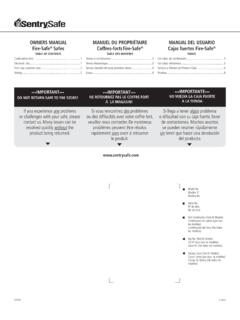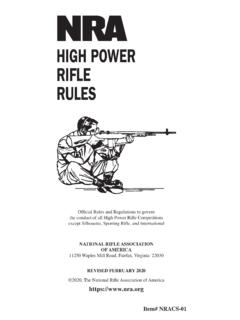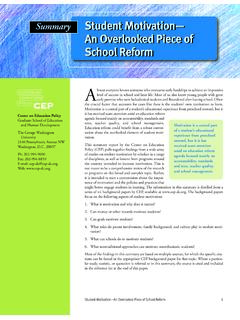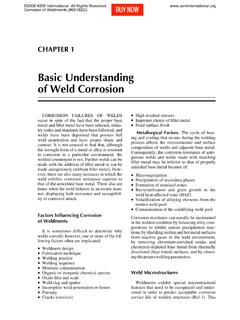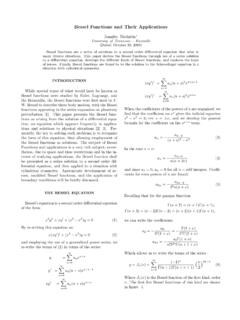Transcription of TH D CONGRESS SESSION S. ll
1 KIN22074 751 S. ll 117TH CONGRESS . 2D SESSION . To amend the Child Care and Development Block Grant Act of 1990 to reauthorize and update the Act, and for other purposes. IN THE SENATE OF THE UNITED STATES. llllllllll Mr. SCOTT of South Carolina (for himself, Mr. BURR, Ms. MURKOWSKI, Ms. COLLINS, Mr. SULLIVAN, Mr. SASSE, Mr. GRASSLEY, Mr. YOUNG, and Mrs. CAPITO) introduced the following bill; which was read twice and re- ferred to the Committee on llllllllll A BILL. To amend the Child Care and Development Block Grant Act of 1990 to reauthorize and update the Act, and for other purposes. 1 Be it enacted by the Senate and House of Representa- 2 tives of the United States of America in CONGRESS assembled, 3 SECTION 1. SHORT TITLE. 4 This Act may be cited as the Child Care and Devel- 5 opment Block Grant Reauthorization Act of 2022''.
2 6 SEC. 2. PURPOSES. 7 (a) REDESIGNATION. Section 658A of the Child 8 Care and Development Block Grant Act of 1990 (42. 9 9857) is redesignated as section 658 of such Act. KIN22074 751 2. 1 (b) AMENDMENT. Subsection (b) of that section 658. 2 is amended to read as follows: 3 (b) PURPOSES. The purposes of this subchapter 4 are . 5 (1) to allow each State maximum flexibility in 6 developing a mixed delivery system to provide child 7 care that best suits the needs of children and work- 8 ing parents within that State;. 9 (2) to promote parental choice to empower 10 working parents to make their own decisions regard- 11 ing the child care services that best suit their fam- 12 ily's needs;. 13 (3) to encourage States to provide consumer 14 education information to help parents make in- 15 formed choices about child care services and to pro- 16 mote involvement by parents and family members in 17 the development of their children in child care set- 18 tings.
3 19 (4) to assist States in delivering high-quality, 20 coordinated child care services to maximize parents'. 21 options to cover the full workday and full work year, 22 to support continuity of care for children, and to 23 support parents trying to achieve independence from 24 public assistance;. KIN22074 751 3. 1 (5) to assist States in improving the overall 2 quality of child care by implementing the health, 3 safety, licensing, early learning and development, 4 professional, and oversight standards established in 5 this subchapter and in State law (including State 6 regulations);. 7 (6) to assist States . 8 (A) in supporting the education and pro- 9 fessional development of child care staff; and 10 (B) in supporting child care providers in 11 the recruitment of, professional development 12 for, and retention of a qualified child care work- 13 force; and 14 (7) to increase the number and percentage of 15 low-income children in high-quality child care set- 16 tings.
4 ''. 17 (c) RULE OF CONSTRUCTION. The term child 18 care'' as used in this subchapter includes preschool, pre- 19 kindergarten, and early childhood education for children 20 birth to 5 and before school, after school, and summer 21 care for school-age children. 22 SEC. 3. DEFINITIONS. 23 (a) IN GENERAL. Section 658P of the Child Care 24 and Development Block Grant Act of 1990 (42 25 9858n) is amended . KIN22074 751 4. 1 (1) by redesignating paragraphs (2) and (3), 2 (4) through (7), (8) and (9), and (10) through (15), 3 as paragraphs (3) and (4), (6) through (9), (11) and 4 (12), and (14) through (19), respectively;. 5 (2) by inserting after paragraph (1) the fol- 6 lowing: 7 (2) CHILD CARE. The term child care' in- 8 cludes preschool, prekindergarten, and early child- 9 hood education for children from birth through age 10 5, and before school, after school, and summer care 11 for school-age children.
5 '';. 12 (3) in paragraph (4), as so redesignated . 13 (A) in subparagraph (B), by inserting 14 and'' at the end;. 15 (B) in subparagraph (C), by striking ;. 16 and'' at the end and inserting a period; and 17 (C) by striking subparagraph (D);. 18 (4) by striking paragraph (6), as so redesig- 19 nated, and inserting the following: 20 (5) ELIGIBLE ACTIVITY. The term eligible 21 activity', means an activity consisting of . 22 (A) full-time or part-time employment;. 23 (B) self-employment;. 24 (C) job search activities;. 25 (D) job training;. KIN22074 751 5. 1 (E) secondary, postsecondary, or adult 2 education, including education through a pro- 3 gram of high school classes, a course of study 4 at an institution of higher education, classes to- 5 wards an equivalent of a high school diploma 6 recognized by State law, or English as a second 7 language classes.
6 8 (F) health treatment (including mental 9 health and substance use treatment) for a con- 10 dition that prevents the parent involved from 11 participating in other eligible activities;. 12 (G) activities to prevent child abuse or 13 neglect, or family violence prevention or inter- 14 vention activities;. 15 (H) employment and training activities 16 under the supplemental nutrition assistance 17 program established under section 6(d)(4) of 18 the Food and Nutrition Act of 2008 (7 19 2015(d)(4));. 20 (I) employment and training activities 21 under the Workforce Innovation and Oppor- 22 tunity Act (29 3101 et seq.);. 23 (J) a work activity described in sub- 24 section (d) of section 407 of the Social Security 25 Act (42 607) for which, consistent with KIN22074 751 6.
7 1 clauses (ii) and (iii) of section 402(a)(1)(A) of 2 such Act (42 602(a)(1)(A)), a parent is 3 treated as being engaged in work for a month 4 in a fiscal year for purposes of the program of 5 block grants to States for temporary assistance 6 for needy families established under part A of 7 title IV of the Social Security Act (42 8 601 et seq.); or 9 (K) taking leave under the Family and 10 Medical Leave Act of 1993 (29 2601 et 11 seq.) (or equivalent provisions for Federal em- 12 ployees), a State or local paid or unpaid leave 13 law, or a program of employer-provided leave. 14 (6) ELIGIBLE CHILD. The term eligible 15 child' means an individual . 16 (A) who is less than 13 years of age;. 17 (B)(i)(I) whose family income does not 18 exceed 85 percent of the State median income 19 for a family of the same size; or 20 (II) in the case of a State that has deter- 21 mined it is necessary to serve additional chil- 22 dren, after ensuring that all eligible children de- 23 scribed in subclause (I) have had an appro- 24 priate opportunity to receive services under this 25 subchapter, whose family income does not ex- KIN22074 751 7.
8 1 ceed a State limit that is not more than 150. 2 percent of the State median income for a family 3 of the same size; and 4 (ii) whose family assets do not exceed 5 $1,000,000 (as certified by a member of such 6 family); and 7 (C) who . 8 (i) resides with a parent or parents 9 who are participating in an eligible activ- 10 ity;. 11 (ii) is a child experiencing homeless- 12 ness, a child in kinship care, or a child who 13 is receiving, or needs to receive, child pro- 14 tective services; or 15 (iii) resides with a parent who is 16 more than 65 years of age.'';. 17 (5) in paragraph (8), as so redesignated . 18 (A) in subparagraph (A), by striking or''. 19 at the end;. 20 (B) in subparagraph (B) . 21 (i) by inserting the child (if the 22 spouse of such provider is engaged in an 23 eligible activity),'' after decree,''; and 24 (ii) by striking the period at the end 25 and inserting ; or''; and KIN22074 751 8.
9 1 (C) by added at the end the following: 2 (C) notwithstanding section 645(a)(1)(B). 3 of the Head Start Act (42 4 9840(a)(1)(B)), a Head Start agency.'';. 5 (6) by striking paragraph (9), as so redesig- 6 nated, and inserting the following: 7 (9) FAMILY CHILD CARE PROVIDER. The 8 term family child care provider' means an individual 9 who provides child care services in a private resi- 10 dence . 11 (A) for fewer than 24 hours per day per 12 child; or 13 (B) for 24 hours per day per child due to 14 the nature of the work of the parent involved. 15 (10) HOMELESS CHILD. The term homeless 16 child' means an individual described in section 17 725(2) of the McKinney-Vento Homeless Assistance 18 Act (42 11434a(2)).'';. 19 (7) in paragraph (11), as so redesignated, by 20 striking (11)'' and all that follows through mean- 21 ing'' and inserting the following: 22 (11) INDIAN TRIBE; INDIAN TRIBE.
10 The term 23 Indian Tribe' or Indian tribe' has the meaning'';. 24 (8) by inserting after paragraph (12), as so re- 25 designated, the following: KIN22074 751 9. 1 (13) MIXED DELIVERY SYSTEM. The term 2 mixed delivery system' means a system of child care 3 services that . 4 (A) promotes parental choice to empower 5 working parents to make their own decisions re- 6 garding the child care services that best suit 7 their family's needs;. 8 (B) delivers services through a combina - 9 tion of programs offered by eligible child care 10 providers (including faith-based and commu- 11 nity-based child care providers) in a variety of 12 settings (including family child care homes, 13 child care centers, Head Start centers, and pub- 14 lic and private schools); and 15 (C) is supported with a combination of 16 public and private funds.
